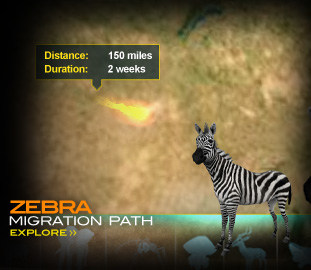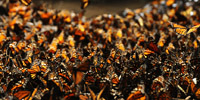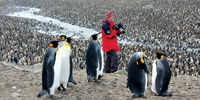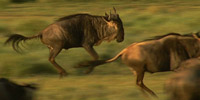Zebra
Animals — Zebra
INTERACTIVE ZEBRA PROFILE
ZEBRA (Equus Burchellii)
There are three species of zebras in Africa. The plains zebra, also known as Burchell’s zebra, is the most numerous and widespread. Grevy’s zebra (Equus grevyi) is found mostly in northeastern Kenya, and the mountain zebra (Equus zebra) is found in southern and southwestern Africa, including Botswana. Zebras’ diet consists of short grasses, plus occasional herbs, leaves and twigs.
Plains zebras, like wildebeest and kob, must migrate to find fresh grazing land and water. In Botswana, one of the largest zebra migrations on the continent takes place each year, as some 25,000 zebra follow the rains and cross from the Okavango Delta to the Makgadikgadi Salt Pan grasslands to the southeast, stopping at hundreds of water holes along the way, and then eventually return westward to the Okavango Delta.
During the long, dangerous journey, zebras must be extremely wary of the predators who track their movements. Zebras move in dense herds of 1,000 or more animals because their stripes blend together, making it difficult for predators to single out individuals that they can stalk. The herd also possesses many sets of eyes that are simultaneously on the lookout. When a zebra is attacked, other family members may attempt to defend it by encircling it.
Throughout southern and southeastern Africa, plains zebras play a subtle but crucial role in the savanna ecosystem, by preparing the grasslands for for other grazing animals. They are the first to graze, and they chomp down on old growth and stems which keeps vegetation young and growing, and exposes the grasses that wildebeest, gazelles, and other creatures eat. Without them, Wildebeest have a difficult time finding food.
MORE MIGRATIONS
-
Preserve their HabitatHelp conserve the natural landscapes of these migratory species.
-
Teacher ResourcesJoin the virtual assembly and access lesson plans specific to your area.
-
Nat Geo ExpeditionsTake a migration of your own with National Geographic Explorers.
-
Science Behind MigrationsHow do animals decide where to go, how long to stay, and when to leave?















